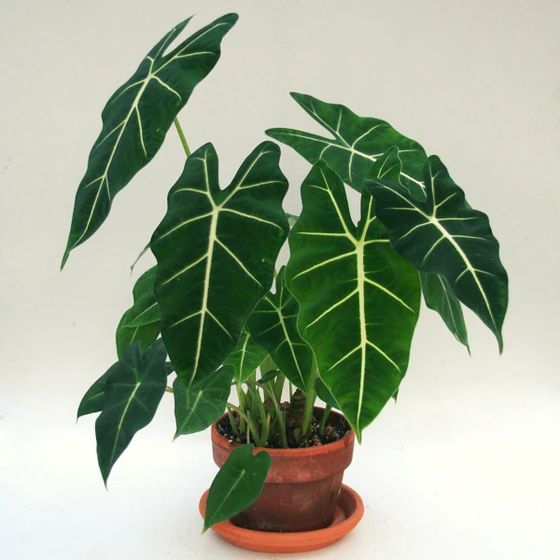Table of Contents
1. Understanding Frydek Elephant Ear
1.1 Origins and Characteristics
Frydek Elephant Ear, scientifically known as Alocasia micholitziana, is native to the rainforests of Southeast Asia. It features large, arrowhead-shaped leaves with prominent veins and striking silver-green foliage. The plant can reach a height of up to three feet, adding a touch of tropical elegance to any indoor or outdoor space.



2. Creating the Perfect Environment
2.1 Light Requirements
Frydek Elephant Ear thrives in bright, indirect light. Placing it near a north or east-facing window is ideal, as it ensures the plant receives the right amount of sunlight without being exposed to harsh, direct rays. However, it’s important to avoid placing the plant in deep shade as it may hinder its growth.
2.2 Temperature and Humidity
Maintaining a warm and humid environment is crucial for the well-being of Frydek Elephant Ear. Ideally, temperatures between 65°F and 80°F (18°C to 27°C) are optimal. Additionally, misting the leaves regularly or placing a humidifier nearby can help recreate the high humidity levels that the plant thrives in.
3. Soil and Watering
3.1 Choosing the Right Soil
To provide the best growing conditions for Frydek Elephant Ear, it’s essential to select well-draining soil with good moisture retention. A mixture of peat moss, perlite, and regular potting soil works well, allowing excess water to drain while keeping the soil moist.
3.2 Watering Techniques
Proper watering is crucial to prevent the plant from becoming too dry or overly saturated. Aim to keep the soil slightly moist at all times, but be cautious not to overwater. Regularly check the top inch of soil, and when it feels slightly dry to the touch, water the plant thoroughly, allowing the excess water to drain away.
4. Feeding and Fertilization
4.1 Nutritional Needs
Frydek Elephant Ear is a relatively heavy feeder and requires regular fertilization to maintain its lush foliage. During the growing season, which typically spans from spring to early fall, use a balanced liquid fertilizer diluted to half strength every two to three weeks. This will provide the plant with essential nutrients for healthy growth.
4.2 Fertilizer Application
Apply the diluted fertilizer directly to the soil, ensuring that it reaches the root zone. Avoid fertilizing the leaves as it can lead to burns or damage. Once the growing season ends, reduce the frequency of fertilization to once a month or as needed.
5. Pruning and Propagation
5.1 Pruning Tips
Pruning Frydek Elephant Ear is primarily focused on removing any damaged or diseased leaves. Use clean, sharp pruning shears to make clean cuts, minimizing the risk of infection. Additionally, removing any yellowing or withered leaves helps maintain the plant’s overall appearance.
5.2 Propagation Methods
Propagating Frydek Elephant Ear can be done through division or stem cuttings. Dividing the plant involves separating the offsets or tubers from the mother plant and planting them individually. Alternatively, stem cuttings can be taken from healthy stems and rooted in a well-draining medium until they develop roots.
6. Common Pests and Diseases
6.1. Identifying Pests
Frydek Elephant Ear is susceptible to common houseplant pests, including aphids, mealybugs, and spider mites. Regularly inspect the leaves for signs of infestation, such as sticky residue, tiny webs, or distorted growth.
6.2 Effective Pest Control
Treating pest infestations promptly is essential to ensure the health of the plant. Options include using insecticidal soap, neem oil, or wiping the leaves with a mild soap and water solution. Introducing natural predators, such as ladybugs, can also help control certain pests.
7. Troubleshooting Guide

7.1 Yellowing Leaves
Yellowing leaves in Frydek Elephant Ear may indicate overwatering, inadequate light, or nutrient deficiencies. Adjusting the watering schedule, providing more indirect light, and ensuring proper fertilization can help address these issues.

7.2 Leaf Curling
Leaf curling can be a sign of low humidity levels or pest infestation. Increasing humidity by misting or using a humidifier and addressing any pest problems can help resolve leaf curling.
8. FAQs
- Is Frydek Elephant Ear suitable for indoor or outdoor cultivation?
Frydek Elephant Ear can thrive both indoors and outdoors. It adapts well to indoor environments with proper light and humidity levels, making it a popular choice among houseplant enthusiasts. Outdoors, it thrives in tropical and subtropical regions.
- How often should I water Frydek Elephant Ear?
Water Frydek Elephant Ear when the top inch of soil feels slightly dry. Avoid overwatering, as it can lead to root rot. Ensure proper drainage to prevent waterlogging.
- Can I grow Frydek Elephant Ear in direct sunlight?
While Frydek Elephant Ear enjoys bright light, direct sunlight can scorch its leaves. Place the plant near a north or east-facing window to provide it with the right amount of indirect light.
- How can I increase humidity for Frydek Elephant Ear?
To increase humidity, mist the leaves regularly or place a humidifier nearby. You can also create a pebble tray by filling a shallow tray with water and placing the plant on top, ensuring the water doesn’t touch the pot’s bottom.
- What should I do if my Frydek Elephant Ear develops yellow leaves?
Yellowing leaves can indicate various issues, such as overwatering, inadequate light, or nutrient deficiencies. Adjust the watering schedule, provide more indirect light, and ensure proper fertilization to address the problem.
9. Conclusion
Frydek Elephant Ear is a magnificent plant that brings a touch of tropical beauty to any space. By following the care and maintenance guidelines outlined in this article, you can ensure that your Frydek Elephant Ear thrives and displays its vibrant foliage to its full potential. Remember to provide the ideal growing conditions, water appropriately, fertilize regularly, and address any issues promptly to enjoy the stunning beauty of this remarkable plant.
If you have any questions, you can contact us via:
- Instagram: Xanh Xanh Urban Forest
- Facebook: Xanh Xanh Urban Forest

